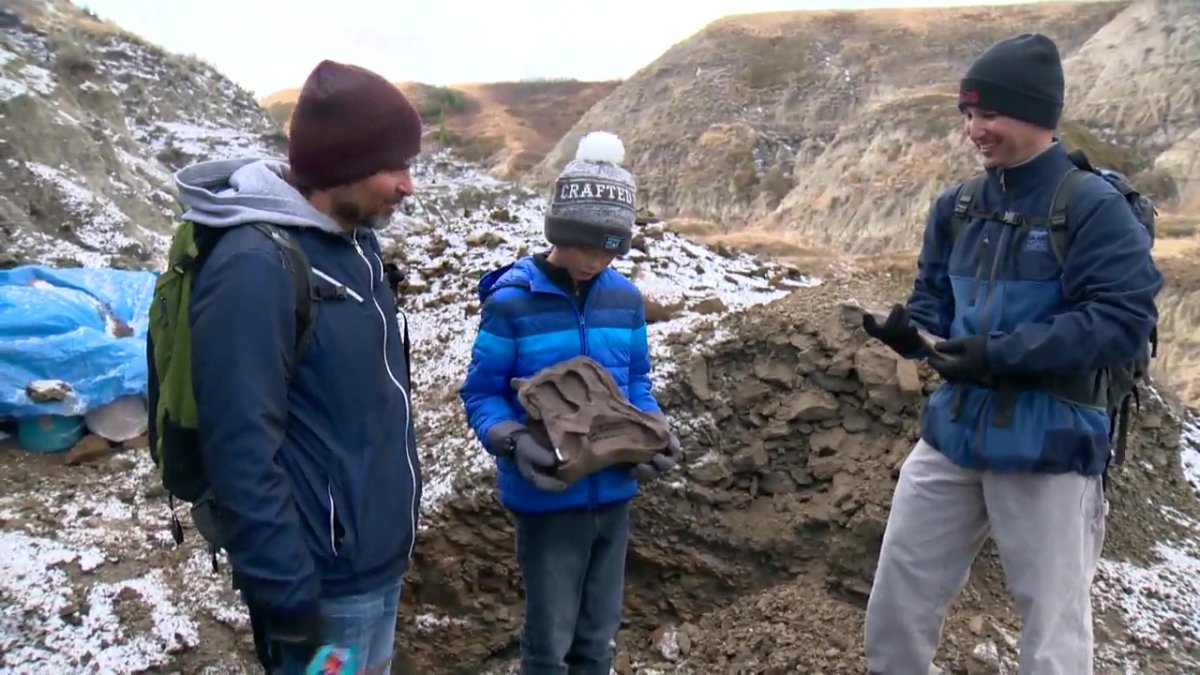Aspiring paleontologist Nathan Hrushkin speaks with pride about his “killer resume.”
The Grade 7 student from Calgary discovered a rare dinosaur skeleton earlier this year at Horseshoe Canyon in the Badlands region of southeastern Alberta, on the Nature Conservancy of Canada conservation lands.
It’s a significant find that one expert says fills a gap in the knowledge of dinosaur evolution.
“I really wanted to be a paleontologist before (and) now that I’ve found something already, at only 12 years old… I’d have a pretty killer resume,” Nathan said with a laugh during a phone interview.

He said he was on a hike with his father and a few friends on a sunny, hot day in late June, when he saw a bone protruding from the ground.
“The first thing I said was, ‘Oh my God, Dad. You need to get up here!'”
After emailing photos of the discovery to the Royal Tyrrell Museum of Paleontology in Drumheller, Alta., Nathan and his dad learned that the bone belonged to a young hadrosaur, also known as a duck-billed dinosaur because its pointed snout is similar to a duck’s.
Hadrosaurs could grow up to 13 metres long and roamed Alberta while triceratopses and tyrannosaurs ruled the Earth, said Francois Therrien, curator of dinosaur paleoecology at the Royal Tyrrell Museum, who responded to Nathan’s’ email.
Therrien said the three- to four-year-old hadrosaur lived about 69 million years ago. It’s a time period experts don’t know much about “in terms of dinosaurs living here in Canada and even in the western interior of North America,” said Therrien.
“We have very little information about what’s going on.
“That discovery by little Nathan is of great significance. Because it is one more piece to that puzzle.”
Therrien said the find can help archeologists learn more about, not just the evolution of dinosaurs, but also how they responded to their changing climate and environment.

“I’m really excited because that time interval in the Earth’s history is a time of important environmental and climatic changes. There’s periods of rapid cooling, rapid warming, dropping rainfall, more humid conditions,” Therrien said.
“My interest is figuring out what’s happening to the animals during that time, especially dinosaurs.
“How are they faring with those periods of global climatic changes?”
On Thursday, Nathan and his dad were to join Therrien and his team in extracting the final pieces of the approximately three-metre-long hadrosaur, including its partial skull. The pieces are to be placed in protective jackets made of burlap and plaster and sent to the museum’s lab for cleaning and research.

The Nature Conservancy of Canada said that since Nathan’s find, paleontologists have uncovered between 30 and 50 bones in the canyon’s wall.
The group stressed this spot is on a conservation area and is asking people to respect the site, stick to the trails and not collect things along the way.
“The Nature Conservancy of Canada site is home to many at risk plant and animal species,” said Andrew Holland, the conservancy’s spokesperson.

Therrien said the youngster’s response to the discovery is a textbook example of what the public should do when they come across fossils, bones and other skeletons in the area — contact the museum.
As for Nathan, he said working with Therrien has helped him discover a lot about himself, too.
His love for dinosaurs had made it difficult for him to choose a favourite.
Now, he says, it’s a juvenile hadrosaur.




— With a file from Global News







Comments